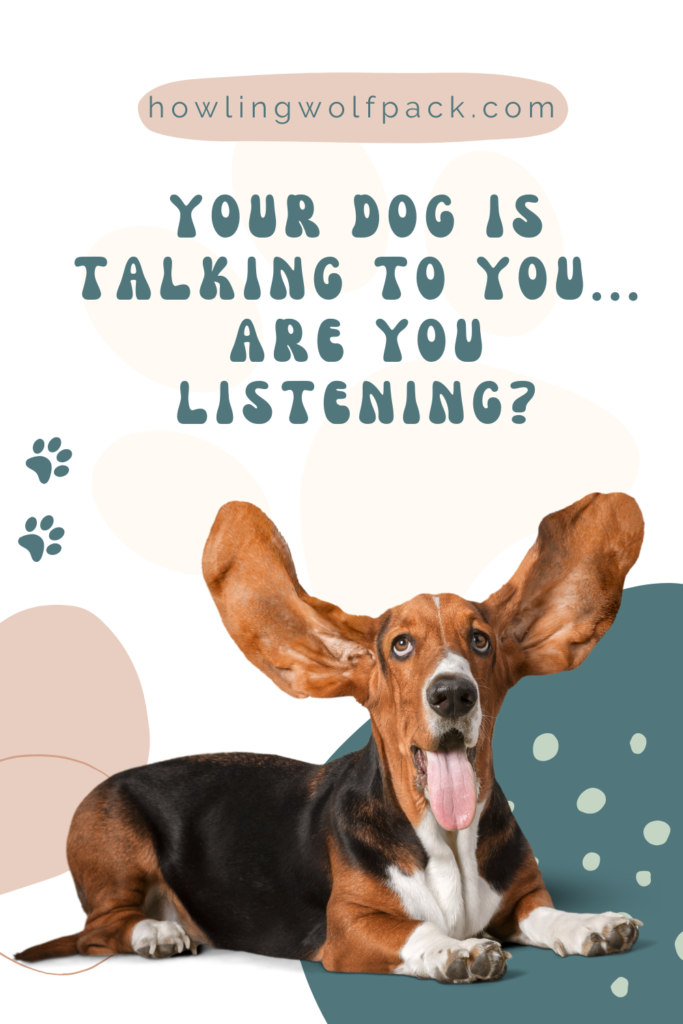Our dogs are communicating with us during every interaction of their day. Instead of words, they use facial expressions, vocalizations and body language. They are sending us direct messages and it’s our job to read the cues and communicate back to them through our own actions.
Of course, a lot of dog behaviour is intuitive such as a play bow showing your dog wants to initiate play and a dog avoiding eye contact is a clear sign the dog is stressed and uncomfortable but below is a list of not so intuitive dog behaviours you might be surprised to learn about.

What are the most common dog behaviors?
Dropped or Pinned Ears
The term dropped or pinned ears refers to ears that appear pasted/pinned or dropped and held tight to the dog’s head. Dogs can drop/lower their ears when they are both happy and nervous. It’s important to read the rest of the dog. A happy dog will have dropped ears and a loose neutral body. On the other hand, a nervous or fearful dog will have their ears extremely pinned back and their body will be more hunched and stiff.
Whale Eyes
When a dog shows the whites of its eyes (the sclera), it is known as “whale eye”. It’s a signal they are feeling anxious or stressed in a situation. Your dog is hoping you notice their eyes and can pick up on this subtle message. Try removing them from the situation / object which is causing them the discomfort.
Raised Hackles
A dog’s hackles consist of the hairs along the backbone. They generally start from the neck area and go up to the tail. When a dog’s hackles are raised, it means the hair along their back is standing up, also known as piloerection. This is a definite sign that the dog is aroused, but not necessarily in a negative way. The dog might be upset or stressed but could also be excited or intensely interested in something. It is important to read the other body language your dog is exhibiting to know how to best respond.
Yawning
Dogs yawn when they are feeling anxious or stressed. According to Turid Rugaas, author of ‘On Talking Terms With Dogs: Calming Signals,’ dogs use yawning to calm themselves in tense situations. Yawning is also used to communicate indifference to other dogs. When a dog is faced with an aggressive dog, he may offer a yawn in response to the aggressor. This simply means that the yawning dog is not interested in any sort of conflict. Did you know that yawns are contagious to dogs, as well! Dogs will yawn in response to another dog yawning, and they will also yawn in response to humans yawning, especially if it’s a human they know well. Many believe this is a sign that dogs are empathetic to both fellow canines and humans alike.
Nose And Lip Licking
Just like people, dogs will lick their lips after a delicious meal, but they will also do it when they feel anxious. Many veterinarians associate lip-licking behaviors with stress and anxiety1. Look for this lip-licking signal in situations where your dog may feel threatened or otherwise anxious or worried. You can help your dog to manage his anxiety by offering a friendly word of encouragement or a quick pat.
Baring Teeth
When a dog bares their teeth they are sending a clear message to back off. They’re warning: “I am going to use these teeth if you don’t stop it.” This type of body language is often accompanied by growling and snarling. If your dog’s warning is ignored, the behavior will likely progress to snapping or biting. Dogs display aggression for a number of reasons, such as fear, feeling overwhelmed, pain and territoriality2. No matter the reason why, bared teeth are usually a sign they are being pushed past their comfort zone.
Tail Wagging
A wagging tail can be easily misunderstood. A wagging tail doesn’t always mean the dog is happy but it does mean the dog is emotionally aroused. It could be excitement, but it could also be frustration. To interpret the dog’s emotions and intentions, look at the speed and direction of the wag as well as the position of the tail. Excited dogs hold their tails higher than a neutral position, and wag them quickly from side to side. An uncertain or nervous dog will also wag their tail, but their tail will be slightly lower than a neutral position and wagged slower and more steadily. A recent study on tail-wagging3 showed that dogs tend to wag more to the right when they feel positive about something, like interacting with their owner. Tails wagged more to the left when dogs faced something negative.
Zoomies
Zoomies, or Frenetic Random Activity Periods (FRAPs), refer to those unmistakable explosions of frantic, repetitive behavior such as running in circles or spinning around. Zoomies are a natural dog behavior and often happen after a bath or by stressful situations like visiting the vet.
Conclusion
Dogs are constantly communicating with us through body language. By learning to recognize different signs like yawning, nose and lip licking, baring teeth, tail wagging, and zoomies, we can better understand how our dogs are feeling in any given situation. Understanding these behaviors can help us create a stronger bond with our dog. Our dogs are talking to us, are you listening?
References
1 Minimising Stress for Patients in the Veterinary Hospital: Why It Is Important and What Can Be Done About It
2 https://doi.org/10.3389/fvets.2018.00115
3 https://doi.org/10.1016/j.cub.2007.02.008
